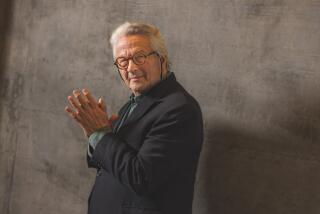In Development : A Film Maker’s Experience Watching His Vision Take Shape
A STEAM ENGINE THUNDERS toward us, belching black smoke.
Men with guns walk down an empty street, spreading out as they come, faces grim.
People cluster around a new-dug grave on the side of a steep hill, a cold wind moaning through the ragged trees that surround them.
A coal-blackened man crawls through a narrow seam under tons of slate, the top dripping, the ribs sweating cold water, puddles at his knees. The headlamp clipped to his hat gives only a candle’s worth of light as he grits his teeth and chops into the coal face in front of him, tunneling deeper into darkness like a man digging his own grave.
Reading these pictures in a sentence gives you one kind of feeling, depending on your experience and imagination. Seeing them on a movie screen, animated by flickering light and existing in sequential time, can give you a very different feeling, can tell you different things. Understanding the differences between the two experiences is the basis of telling stories on film.
Narrative film, what we ordinarily think of as “the movies,” is a combination of literary, theatrical and purely cinematic elements. The story itself and the dialogue--the literary elements--can be written down, though they are rarely published and never considered “literature” on their own. The acting has its roots in theater, though the style may be altered quite a bit from what would go down on a stage. The picture may have some aspects of painting when it is still, but the minute it cuts, moves or somebody moves within it, we are brought into purely cinematic areas. . . .
I’ve learned that when I write movies for other people to make that it’s best not to visualize the ideal movie in my head after I hand in the script. This can only lead to disorientation and disappointment when you finally see the picture. You give it your best shot, wish them luck, and hope for the best. When I work on a movie as a writer and director and control the cutting, the visualization is a constant process involving many people. The original idea may be very explicit, but I know that it won’t take its real shape until we’ve all done our work on it.
It’s like there’s this house you want to build and you know certain specifications you want, sometimes very specific, like the kitchen counter should be 45 inches high, and others more vague, like the living room should be comfortable and--you know--have a lot of light or something. You raise a certain amount of money to build this house and maybe you draw a picture of it or tell somebody who can draw what to put down, and then you hire people who know about plumbing and wiring and roofing and windows and all that. You know you want the tub here and the sink here and maybe the plumber tells you it would work much better here and here, and maybe you do it his way or maybe yours. When the house is finished you hope it feels like the one you imagined way back when, but of course the oak was too expensive and you had to go with yellow pine and they don’t make kitchen counters that height and customizing was out of the question, but then the woman who put in the windows had this great idea--you never would have thought of it in a million years. The closet on the second floor is always going to be a problem and you try not to think about it when you think about the house. After a bit the house takes on its own character, and though you had a lot to do with how it is, it exists as this thing and it’s hard to imagine it any other way.
“Matewan” in script form was one thing, a potential for action, a story waiting to get told. During the shooting, it was more amorphous, a thousand situations and relationships constantly changing that produced this half-cooked material on film stock. It was still mostly potential, but certain bridges were burned each day, certain forks in the road chosen. Other people’s ideas began to pump into the story, characters got faces, names on a page became three-dimensional. During the editing, the material shot in production was collected and shaped, the story refined from it. Possibilities became choices, choices became inevitabilities. You can’t imagine another actor playing a character; the four takes you have of a shot, the three angles you have of a scene, become finite worlds. The scene as written may no longer be possible given the footage you have, or it may no longer be desirable now that you’ve seen it played out. As you “lock” each reel of the picture it becomes a thing, with its own character that won’t change anymore. If you stay away from the movie long enough, you may even forget where you were standing when a certain shot was taken, may forget the trouble you had leveling the dolly track in the mud and the bees that attacked the catering table at lunch that day. Whole scenes that were shot and edited and finally cut from the movie seem to no longer exist, like a wall that once
stood between your living room and hallway.
You work that hard for that long with people and the production isn’t just what you do for a living, it becomes your life; the people working with you become your community. The strangest and nicest thing during shooting was that even though all of us were neck-deep in the technical demands of making the movie, of creating the illusions that would eventually tell the story, the story would sometimes just pull us out of all that and make us pay attention and think about what had brought us all together. It might be a shot in dailies or the look of an extra when he walked down the tracks covered in coal dust or an actor really connecting with an emotion during a take or maybe just walking into the tent camp at night with the mist hanging low, but the movie was already asserting its character, letting us know what it was supposed to be, like it was out there all the time just waiting, waiting up in those hills for us to find it.
From “Thinking in Pictures: The Making of the Movie Matewan,” by John Sayles, published by Houghton Mifflin Co., Boston. Copyright 1987 by John Sayles. Reprinted by permission.
More to Read
Only good movies
Get the Indie Focus newsletter, Mark Olsen's weekly guide to the world of cinema.
You may occasionally receive promotional content from the Los Angeles Times.










